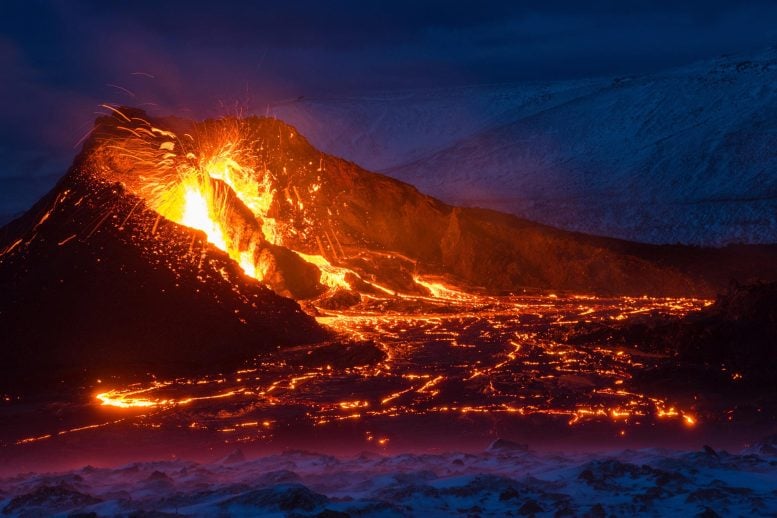
Scientists from UC San Diego’s Scripps Institution of Oceanography have discovered geochemical signatures of magma pooling beneath the surface during Iceland’s 2021 Fagradalsfjall Fires.
Iceland’s most recent volcanic episode on the Reykjanes peninsula, set to last centuries, began with vast magma pooling just beneath the surface.
Researchers at UC San Diego’s Scripps Institution of Oceanography detected magma pooling beneath Iceland’s Fagradalsfjall volcano during the 2021 eruption. Continuous sampling revealed crustal contamination in early lavas, contrary to previous beliefs. This study highlights the importance of crustal magma storage in volcanic activity.
Geochemical Signatures and Magma Pooling
Scientists from the University of California, San Diego’s Scripps Institution of Oceanography have detected geochemical signatures of magma pooling and melting beneath the subsurface during the “Fagradalsfjall Fires,” that began on Iceland’s Reykjanes peninsula in 2021.
Continuous sampling of the erupted lavas from the Fagradalsfjall volcano enabled a detailed time-series analysis of geochemical signals. These show that the start of the eruption began with the massive pooling of magma, contrasting the initial hypothesis for magma ascent straight from the mantle.
Scripps Oceanography geologist James Day and his colleagues report on the analyses today (July 31) in the journal Nature.
Volcanic ‘Blood’ and Geochemical Analysis
“By collecting lavas in regular intervals, and then measuring their compositions in the laboratory, we can tell what’s feeding the volcano at depth,” said study lead Day. “It’s a bit like taking regular measurements of someone’s blood. In this case, the volcano’s ‘blood’ are the molten lavas that emanate so spectacularly from it.”
Day, students at Scripps Oceanography, and international colleagues have been studying basaltic lavas from other recent volcanic eruptions in addition to Iceland. These include the 2021 eruption of the Tajogaite volcano on the island of La Palma in the Canary Islands and the 2022 eruption of Mauna Loa in Hawai’i. They have found evidence for similar magma pooling beneath La Palma.
Importance of Crustal Magma Storage
“What makes the Iceland eruption so remarkable is the huge signal of crust within the earliest lavas,” said Day. “Along with our studies from La Palma, it suggests crustal magma storage may be a common process involved in the run up to larger basaltic eruptions like those in Iceland or the Canary Islands. This information will be important for understanding volcanic hazard in the future,” he added, “as it may help to forecast volcanic activity.”
Previous studies had suggested that the Fagradalsfjall Fires erupted from the surface without interaction with the crust. Day’s team, including UC San Diego undergraduate student Savannah Kelly, used the isotopic composition of the element osmium to understand what was happening beneath the volcano.
“What’s useful about using osmium,” said Day, “is that one of its isotopes is produced by the radiogenic decay of another metal, rhenium. Because the elements behave differently during melting, one of the elements, rhenium, is enriched in Earth’s crust.” Day and colleagues took advantage of the distinct behaviors of rhenium and osmium to show that the early lavas from the Fagradalsfjall Fires were contaminated by crust.
Earth’s Layers and Volcanic Processes
Earth can be broken up into a series of layers. The deepest portion is the metallic core. The shallowest layers are the atmosphere, ocean, and the rocky crust. All human beings live on the crust, which is dominated by rock types such as granite or basalt like that found in Iceland’s lavas. In between the core and crust is the vast mantle of the Earth. This mantle layer is where melting occurs to produce the magmas feeding volcanoes like those in Iceland.
Previous works published on the recent volcanic eruptions on the Reykjanes Ridge had used other geochemical fingerprints to study the lavas. These fingerprints suggested only mantle contributions to the lavas. Osmium isotopes are highly sensitive to crust and enabled the unambiguous identification of its addition into the early lavas.
Surprising Findings From Early Lavas
“The work began as undergraduate research experience for Savannah (Kelly) and we fully expected to see mantle signatures in the lavas throughout the eruption,” said Day. “You can imagine our astonishment when we were sitting in front of the mass spectrometer measuring the early samples and saw obvious signals of crust within them.”
The team analyzed lavas erupting from the Fagradalsfjall volcano in 2021 and in 2022. The 2021 lavas were contaminated by crust, the 2022 lavas were not. They conclude that the earliest lavas pooled in the crust and interaction with the crust may have helped trigger the eruption.
“After that, it appears that the magma of later eruptions used pre-existing pathways to get to the surface,” Day said.
Long-Term Significance of Volcanic Studies
Day and colleagues plan to continue their work on Iceland and other basaltic eruptions into the future. Previous eruptions on the Reykjanes peninsula have lasted for centuries.
“It seems that the volcanic ‘fires’ in Iceland will outlast me,” Day said. “The eruptions that are likely to continue there will provide a treasure trove of important scientific information on how volcanoes work and their associated hazards. Our study shows that the beginning of the eruption was not just visually spectacular, but was also geochemically so.”
Reference: “Deep crustal assimilation during the 2021 Fagradalsfjall Fires, Iceland” 31 July 2024, Nature.
DOI: 10.1038/s41586-024-07750-0
Besides Day and Kelly, Geoffrey Cook of Scripps Oceanography, William Moreland and Thor Thordarsson from the University of Iceland, and Valentin Troll from Uppsala University in Sweden were involved in the research. The National Science Foundation (NSF) Petrology and Geochemistry program partly funded the research.

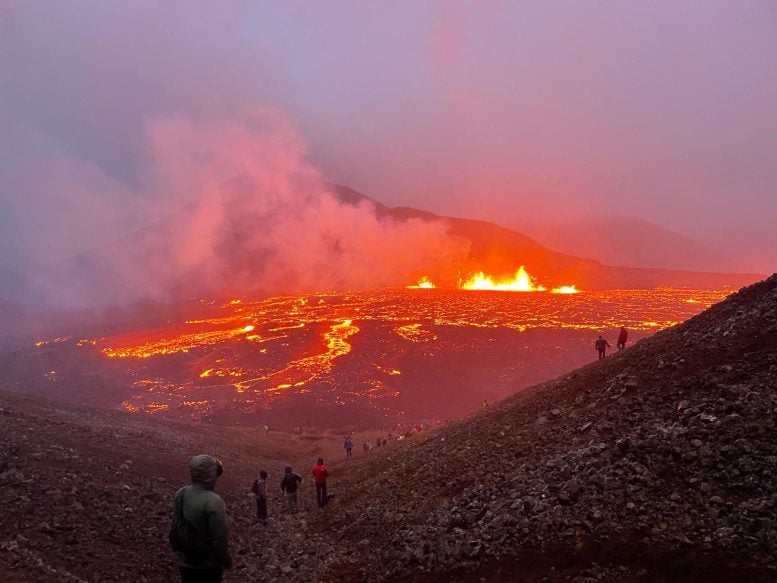

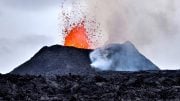



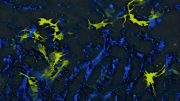

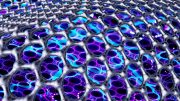
Be the first to comment on "Iceland’s Fiery Volcano: Geochemical Analysis Reveals Hidden Magma Pools"